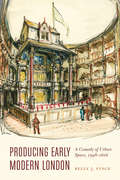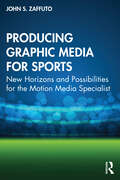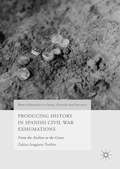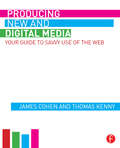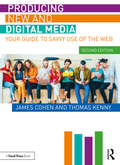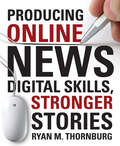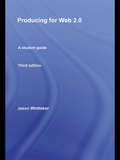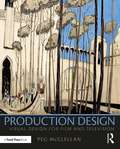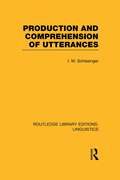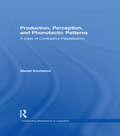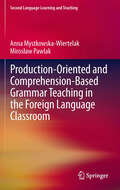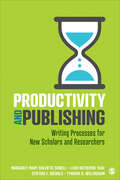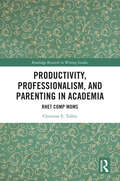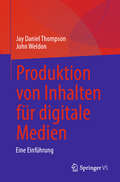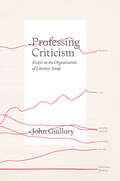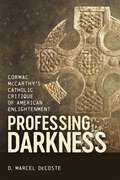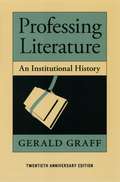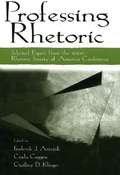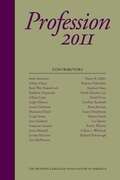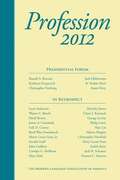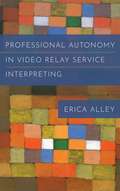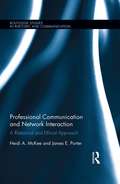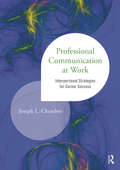- Table View
- List View
Producing Early Modern London: A Comedy of Urban Space, 1598–1616 (Early Modern Cultural Studies)
by Kelly J. StageEarly seventeenth-century London playwrights used actual locations in their comedies while simultaneously exploring London as an imagined, ephemeral, urban space. Producing Early Modern London examines this tension between representing place and producing urban space. In analyzing the theater’s use of city spaces and places, Kelly J. Stage shows how the satirical comedies of the early seventeenth century came to embody the city as the city embodied the plays. Stage focuses on city plays by George Chapman, Thomas Dekker, William Haughton, Ben Jonson, John Marston, Thomas Middleton, and John Webster. While the conventional labels of “city comedy” or “citizen comedy” have often been applied to these plays, she argues that London comedies defy these genre categorizations because the ruptures, expansions, conflicts, and imperfections of the expanding city became a part of their form. Rather than defining the “city comedy,” comedy in this period proved to be the genre of London. As the expansion of London’s social space exceeded the strict confines of the “square mile,” the city burgeoned into a new metropolis. The satiric comedies of this period became, in effect, playgrounds for urban experimentation. Early seventeenth-century playwrights seized the opportunity to explore the myriad ways in which London worked, taking the expected—a romance plot, a typical father-son conflict, a cross-dressing intrigue—and turning it into a multifaceted, complex story of interaction and proximity.
Producing Graphic Media for Sports: New Horizons and Possibilities for the Motion Media Specialist
by John S. ZaffutoProducing Graphic Media for Sports: New Horizons and Possibilities for the Motion Media Specialist explores the origins, applications, and future of the production of sports-oriented motion graphics. Beginning with the evolution and development of sports-oriented art and design, this book investigates the importance of motion graphics within a variety of environments in the sphere of organized, competitive activity. Venue-based presentation, broadcast and streaming environments, and the importance of graphic standards and brand guidelines are all discussed in detail, along with applications within social media and mobile platforms. A final chapter on emerging technologies covers the potential use of motion media for e-sports and other trending developments within the sports world. The author draws on case studies and interviews with sports media professionals to augment his own research and observation of trends and processes and to highlight the exciting career opportunities that exist within the sports presentation and marketing industries. This book is recommended reading for students of advanced media production, sports marketing, and media production for advertising.
Producing History in Spanish Civil War Exhumations: From the Archive to the Grave (World Histories of Crime, Culture and Violence)
by Zahira Aragüete-ToribioThis book reflects on the new histories emerging from the exhumation of mass graves that contain the corpses of the Republicans killed in extrajudicial executions during and after the conflict, nearly eighty years after the end of the Spanish Civil War (1936-1939). In the search for, location and unearthing of these unmarked burials, the corpse, the document and the oral testimony have become key traces through which to demand the recognition of past Francoist crimes, which were never atoned, from a lukewarm Spanish state and judiciary. These have become objects of evidence against the politics of silence entertained by national institutions since the transition to democracy. Working alongside archaeologists, historians, memory activists and families, this book explores how new versions of the history of the killings are constructed at the cross-roads between science, history and family experience. It does so considering the workings of truth-seeking in the absence of criminal justice and the effects of the process on Spanish collective memory and identity.
Producing New and Digital Media: Your Guide to Savvy Use of the Web
by Thomas Kenny James CohenProducing New and Digital Media is your guide to understanding new media, diving deep into topics such as cultural and social impacts of the web, the importance of digital literacy, and creating in an online environment. It features an introductory, hands-on approach to creating user-generated content, coding, cultivating an online brand, and storytelling in new and digital media. This book is accompanied by a companion website--designed to aid students and professors alike--that features chapter-related questions, links to resources, and lecture slides. In showing you how to navigate the world of digital media and also complete digital tasks, this book not only teaches you how to use the web, but understand why you use it. KEY FEATURES For students- a companion site that features research resources and links for further investigation For instructors- a companion site that features lecture slides, a sample syllabus, and an Instructor's Manual. Features a unique approach that covers media studies aspects with production and design tutorials. Covers up-to-date forms of communication on the web such as memes, viral videos, social media, and more pervasive types of online languages.
Producing New and Digital Media: Your Guide to Savvy Use of the Web
by Thomas Kenny James CohenProducing New and Digital Media is your essential guide to understanding new media, taking a deep dive into such topics as the cultural and social impacts of the web, the importance of digital literacy, and creating in an online environment. This cutting edge text provides an introductory, hands-on approach to creating user-generated content, coding, cultivating an online brand, and storytelling in new and digital media. In showing you how to navigate the world of digital media and complete digital tasks, this book not only teaches you how to use the web, but also helps you understand why you use it. Key features for the second edition include: Coverage of up-to-date forms of communication on the web: memes, viral videos, social media, and more pervasive types of online languages. New chapters on YouTube influencers and on-demand subscription television. Each chapter has media literacy sidebars, sample assignments, and activities. Updates to the companion website additional materials for students and instructors Thoughtful, entertaining, and enlightening, this is the fundamental textbook for students of new and digital media, digital culture and media literacy, as well as a useful resource for anyone wanting to understand and develop their presence in our digital world.
Producing Online News: Digital Skills, Stronger Stories
by Ryan M. ThornburgThe dazzling speed of change in online journalism can mask a simple truth: online news is still news. Cutting-edge technology benefits the audience only when journalists apply it in the service of good stories. Building on a foundation of news stories, Producing Online News shows students how to use the right tools to get the right information to the right people at the right time. The goal is to become a full-fledged online news producer and transform stories into a complete news experience for an ever more demanding audience. Ryan Thornburg, a journalism trainer who has managed the websites of top news organizations, hones the skills students need to produce stories using multimedia, interactivity and on-demand delivery- online journalism′s three pillars. Practical instructions show students not just how to use the tools but also how to make good journalistic choices in applying them. The book works for courses specifically in online journalism or for any journalism course that incorporates multiple platforms. Features that make for stronger stories:TOOLS sections walk students through the latest technology- Twitter, Wordpress, Audacity, Caspio, Dipity and more- so their writing gains more immediacy and impact. Real-world examples from both traditional outlets and new-style sites like ProPublica, PolitiFact, BeliefNet and Global Voices showcase journalists connecting with their audiences. View Source boxes uncover the technology behind a specific news project-for example, how do just five editors at Yahoo News publish 2,000 stories a day?News Judgement boxes explore journalistic choices- sure, students can link a story to anything on the web- but should they?
Producing Women's Poetry, 1600-1730
by Gillian WrightProducing Women's Poetry is the first specialist study to consider English-language poetry by women across the seventeenth and early eighteenth centuries. Gillian Wright explores not only the forms and topics favoured by women, but also how their verse was enabled and shaped by their textual and biographical circumstances. She combines traditional literary and bibliographical approaches to address women's complex use of manuscript and print and their relationships with the male-generated genres of the traditional literary canon, as well as the role of agents such as scribes, publishers and editors in helping to determine how women's poetry was preserved, circulated and remembered. Wright focuses on key figures in the emerging canon of early modern women's writing, Anne Bradstreet, Katherine Philips and Anne Finch, alongside the work of lesser-known poets Anne Southwell and Mary Monck, to create a new and compelling account of early modern women's literary history.
Producing for Web 2.0: A Student Guide
by Jason WhittakerPraise for the previous edition: 'Gives an excellent insight into the main issues of creating a website and offers a good foundation of knowledge.' – i.net Producing for Web 2.0 is a clear and practical guide to the planning, set up and management of a website in web 2.0. It gives readers an overview of the current technologies available for online communications and shows how to use them for maximum effect when planning a website. Producing for Web 2.0 sets out the practical toolkit needed for web design and content management. It is supported by a regularly updated and comprehensive Companion Website at: www.producingforweb2.com where readers can see examples of programming and demonstrations of concepts discussed in the book, as well as trying things out themselves. Producing for Web 2.0 includes: illustrated examples of good design and content advice on content, maintenance and how to use sites effectively tips on using multimedia, including video, audio, flash, and images a chapter on ethics and internet regulations for journalists and writers tutorials for the main applications used in website design step by step guides to difficult areas with screenshots guides to good practice for all those involved in publishing news online.
Production Design: Visual Design for Film and Television
by Peg McClellanProduction Design: Visual Design for Film and Television is a hands-on guide to the craft of Production Design and Art Direction. Author Peg McClellan gives an insider’s view of the experiences and challenges of working as a Production Designer in film and television. The book covers three major areas, starting with an overview and the basics of job responsibilities, the artistic approach and the background which every Production Designer needs to be familiar with, and progressing to the mechanics of the role with a day-to-day breakdown of the job itself. McClellan takes you through script analysis, team collaborations, the hierarchy of a production, hiring a team, the business elements, locations, studio facilities, handling change, and everything in between. With case studies, insights from successful Production Designers, and inspiration in the form of over 200 colour photos and illustrations from storyboards to sets, this is the ideal book for students seeking a career in production design, and professionals looking to further their design knowledge.
Production and Comprehension of Utterances: Linguistics: Production And Comprehension Of Utterances (Routledge Library Editions: Linguistics)
by I. M. SchlesingerIn this volume, the author reviews the results of research on language performance and proposes a model of production and comprehension. Although recent developments in linguistics are taken into account, consideration of other requirements of a performance model leads to the conclusion that the grammar the speaker has in mind differs from the grammar as currently conceived of by most linguists. The author is also critical of recent computer simulations of language performance on the basis that they fall short of describing what goes on in human production and comprehension. The author therefore proposes that the basic issues must be rethought and new theoretical foundations reformulated, in order to arrive at a viable theory of language functioning. In developing the framework of the model presented in this book, requirements of flexibility in the performance mechanisms, the probabilistic nature of comprehension processes, and the interleaving of linguistic rules with context and knowledge of the world are emphasized.
Production, Perception, and Phonotactic Patterns: A Case of Contrastive Palatalization (Outstanding Dissertations in Linguistics)
by Alexei KochetovFirst Published in 2002. Routledge is an imprint of Taylor & Francis, an informa company.
Production-oriented and Comprehension-based Grammar Teaching in the Foreign Language Classroom
by Mirosław Pawlak Anna Mystkowska-WiertelakThe book addresses one of the key controversies in teaching foreign language grammar, which is the utility of production-oriented instruction, as exemplified in the PPP sequence, and comprehension-based teaching, as implemented in interpretation tasks and processing instruction. It provides a thorough overview of issues related to learning and teaching grammar, with a particular focus on input-oriented approaches, and reports the findings of four studies which sought to compare their effects with instruction based on different forms of output practice. The findings serve as a basis for guidelines on how the two options can be successfully combined in the classroom
Productivity and Publishing: Writing Processes for New Scholars and Researchers
by Margaret-Mary Sulentic Dowell Leah Katherine Saal Cynthia F. DiCarlo Tynisha D. MeidlProductivity and Publishing: Writing Processes for New Scholars & Researchers by Margaret-Mary Sulentic Dowell, Leah Katherine Saal, Cynthia F. DiCarlo, and Tynisha D. Willingham takes the challenges and confusion out of academic writing and journal publishing by empowering readers to find the writing process that works for them. Activities and writing exercises help readers determine their research agendas, set realistic writing goals, , and follow time-tested and editor-approved processes for writing and revising journal articles. Topics cover the writing and publishing process from start to finish, addressing common issues for new academics like avoiding the blank page, selecting an appropriate journal, dealing with reviews, and leveraging your research into multiple articles and a comprehensive research agenda. Experts weigh in on crucial topics such as scholarly metrics and exposure and offer a journal editor’s perspective on the writing and publishing process. Build your academic career on a solid foundation with Productivity and Publishing.
Productivity and Publishing: Writing Processes for New Scholars and Researchers
by Margaret-Mary Sulentic Dowell Leah Katherine Saal Cynthia F. DiCarlo Tynisha D. MeidlProductivity and Publishing: Writing Processes for New Scholars & Researchers by Margaret-Mary Sulentic Dowell, Leah Katherine Saal, Cynthia F. DiCarlo, and Tynisha D. Willingham takes the challenges and confusion out of academic writing and journal publishing by empowering readers to find the writing process that works for them. Activities and writing exercises help readers determine their research agendas, set realistic writing goals, , and follow time-tested and editor-approved processes for writing and revising journal articles. Topics cover the writing and publishing process from start to finish, addressing common issues for new academics like avoiding the blank page, selecting an appropriate journal, dealing with reviews, and leveraging your research into multiple articles and a comprehensive research agenda. Experts weigh in on crucial topics such as scholarly metrics and exposure and offer a journal editor’s perspective on the writing and publishing process. Build your academic career on a solid foundation with Productivity and Publishing.
Productivity, Professionalism, and Parenting in Academia: Rhet Comp Moms (Routledge Research in Writing Studies)
by Christine E. TulleyDrawing on time use diary analysis, this unique and detailed study fills in the larger narrative about what it takes, hour by hour, to navigate academic motherhood with a rhetoric and composition career.Looking specifically at the intersections between parenting and writing for publication in order to find out how and when writing for career-advancing tasks such as publication occur, but also through the lens of disciplinary time constraints including heavy grading and administrative workloads, the book examines support systems noted within diary entries that make combining motherhood and a career in rhetoric and composition possible. Using both quantitative analysis of hours and qualitative coding of time use diaries from rhet comp moms, this book answers questions about publishing, professionalism, and parenting.This book will interest scholars and graduate students working in the discipline of rhetoric, writing, and composition, particularly those working on labor and professional issues, on gender and equality within the discipline, and anyone working in all fields looking for ways to foster a better work–life balance.
Produktion von Inhalten für digitale Medien: Eine Einführung
by John Weldon Jay Daniel ThompsonDieses Buch bietet eine Einführung in die Produktion digitaler Medieninhalte im einundzwanzigsten Jahrhundert. Dabei werden die Inhalte aus den Berufsfeldern Journalismus, Öffentlichkeitsarbeit und Marketing behandelt. Das Buch gibt einen Einblick, wie Inhalte präsentiert werden und befasst sich mit den rechtlichen und ethischen Fragen, mit denen sich die Produzenten von Inhalten konfrontiert sehen, sowie mit der Frage, wie diese Probleme erfolgreich bewältigt werden können. Die Kapitel enthalten auch Interviews mit Medienfachleuten und Quizfragen, die es den Lesern ermöglichen, das durch die Lektüre des jeweiligen Kapitels erworbene Wissen zu festigen.
Professing Criticism: Essays on the Organization of Literary Study
by John GuilloryA sociological history of literary study—both as a discipline and as a profession. As the humanities in higher education struggle with a labor crisis and with declining enrollments, the travails of literary study are especially profound. No scholar has analyzed the discipline’s contradictions as authoritatively as John Guillory. In this much-anticipated new book, Guillory shows how the study of literature has been organized, both historically and in the modern era, both before and after its professionalization. The traces of this volatile history, he reveals, have solidified into permanent features of the university. Literary study continues to be troubled by the relation between discipline and profession, both in its ambivalence about the literary object and in its anxious embrace of a professionalism that betrays the discipline’s relation to its amateur precursor: criticism. In a series of timely essays, Professing Criticism offers an incisive explanation for the perennial churn in literary study, the constant revolutionizing of its methods and objects, and the permanent crisis of its professional identification. It closes with a robust outline of five key rationales for literary study, offering a credible account of the aims of the discipline and a reminder to the professoriate of what they already do, and often do well.
Professing Darkness: Cormac McCarthy's Catholic Critique of American Enlightenment
by D. Marcel DeCosteProfessing Darkness confirms the centrality of Catholic thought, imagery, and sacrament to the spiritual and ethical outlook of the work of Cormac McCarthy and, more specifically, its consistent assessment of Enlightenment values and their often-catastrophic realization in American history. D. Marcel DeCoste surveys McCarthy’s fiction from both his Tennessee and Southwest periods, with chapters devoted to eight of his published novels—from Outer Dark to The Road—and a conclusion that examines the writer’s screenplay for The Counselor and the duology of The Passenger and Stella Maris. DeCoste’s attentive, wide-ranging interpretations demonstrate that McCarthy’s work mounts a sustained critique of core Enlightenment ideals and their devastating results in the American context, especially for Indigenous peoples, the environment, the viability of community, and the integrity of a self irreducible to the status of a commodity. Professing Darkness shows that Roman Catholic understandings of Penance and Eucharist, along with specific Catholic teachings—such as those regarding the goodness of Creation, the nature of evil, the insufficiency of the self, and the radical invitation to conversion—enable McCarthy’s revelatory engagement with American Enlightenment. An important contribution to the ever-expanding critical literature on a towering contemporary author, Professing Darkness offers an innovative reading of both the spiritual and political valences of McCarthy’s writing.
Professing Literature: An Institutional History
by Gerald GraffWidely considered the standard history of the profession of literary studies, Professing Literature unearths the long-forgotten ideas and debates that created the literature department as we know it today. In a readable and often-amusing narrative, Gerald Graff shows that the heated conflicts of our recent culture wars echo—and often recycle—controversies over how literature should be taught that began more than a century ago. Updated with a new preface by the author that addresses many of the provocative arguments raised by its initial publication, Professing Literature remains an essential history of literary pedagogy and a critical classic. “Graff’s history. . . is a pathbreaking investigation showing how our institutions shape literary thought and proposing how they might be changed.”— The Norton Anthology of Theory and Criticism
Professing Rhetoric: Selected Papers From the 2000 Rhetoric Society of America Conference
by Frederick J. Antczak Geoffrey D. KlingerRepresenting current theory and research in rhetoric, this volume brings together scholarship from a variety of orientations--theoretical, critical, historical, and pedagogical. Some contributions cover work that has previously been silenced or unrecognized, including Native American, African American, Latino, and women's rhetorics. Others explore rhetoric's relationship to performance and to the body, or to revising canons, stases, topoi, and pisteis. Still others are reworking the rhetorical lexicon to comprise contemporary theory. Among these diverse interests, rhetoricians find common themes and share intellectual and pedagogical enterprises that hold them together even as their institutional situations keep them apart. Topics discussed in this collection include: *Rhetoric as figurality; comparative and contrastive rhetorics; rhetoric and gender; and rhetorics of science and technology; *Rhetoric and reconceptions of the public sphere; rhetoric and public memory; and rhetorics of globalization and social change, including issues of race, ethnicity, and nationalism; *Rhetoric's institutionalized place in the academy, in relation to other humanities and to the interpretive social sciences; and *The place of rhetoric in the formation of departments and the development of pedagogy With its origins in the 2000 Rhetoric Society of America (RSA) conference, this volume represents the range and vitality of current scholarship in rhetoric. The conversations contained herein indicate that professing rhetoric is, at the turn of the millennium, an intellectual activity that engages with and helps formulate the most important public and scholarly questions of today. As such, it will be engaging reading for scholars and students, and is certain to provoke further thought, discussion, and exploration.
Profession 2011 (Profession Ser.)
by The Modern Language Association of AmericaThis issue of Profession contains Sidonie Smith's introduction to her Presidential Forum (held at the 2011 MLA convention) and the essays of forum participants Hillary Chute, Marianne Hirsch, Leigh Gilmore, Craig Howes, Françoise Lionnet, Nancy K. Miller, David Palumbo-Liu, Brian Rotman, Leo Spitzer, Robert Warrior, and Gillian L. Whitlock. The issue also features a section on evaluating digital scholarship. Introduced by Susan Schreibman, Laura Mandell, and Stephen Olsen, the section includes essays by Steve Anderson, Kathleen Fitzpatrick, Jerome McGann, Tara McPherson, Bethany Nowviskie, and Geoffrey Rockwell. The issue's other essays are by Reed Way Dasenbrock, Gillian Gane, Laurie Grobman, Joyce Kinkead, David Porter, and Richard Yarborough. The issue concludes with two sets of MLA guidelines--on professional employment practices for non-tenure-track faculty members and on evaluating translations as scholarship--and a listing of reports, surveys, statements, and other resources recently added to the MLA Web site.
Profession 2012 (Profession Ser.)
by The Modern Language AssociationThis issue of Profession contains Russell A. Berman's introduction to his Presidential Forum, Language, Literature, Learning, held at the 2012 MLA convention, and the essays of the forum participants Kathleen Fitzpatrick, Christopher Freeburg, Jack Halberstam, B. Venkat Mani, and Imani Perry. To mark the journal's thirty-fifth anniversary, the issue also features a retrospective sampling of articles that illustrate the evolution of the profession and of the professional issues the journal has addressed since its inception in 1977. The retrospective section includes articles by Leon Anderson; Wayne C. Booth; Heidi Byrnes; James A. Castaeda; Erik D. Curren; Reed Way Dasenbrock; Henry Louis Gates, Jr.; Gerald Graff; John Guillory; Carolyn G. Heilbrun; Mara Holt; Dorothy James; Claire J. Kramsch; George Levine; Philip Lewis; Alan Liu; Helene Moglen; Christopher Newfield; Mary Louise Pratt; Judith Ryan; Jack H. Schuster; and Domna C. Stanton.
Professional Autonomy in Video Relay Service Interpreting (Gallaudet Studies In Interpret #17)
by Erica AlleyVideo relay service (VRS) is a federally funded service that provides telecommunications access for deaf people. It is also a for-profit industry with guidelines that may limit the autonomy of the sign language interpreters who work in VRS settings. In this volume, Erica Alley examines how VRS interpreters, or “Communication Assistants,” exercise professional autonomy despite the constraints that arise from rules and regulations established by federal agencies and corporate entities. Through interviews with VRS interpreters, Alley reveals the balance they must achieve in providing effective customer service while meeting the quantitative measures of success imposed by their employer in a highly structured call center environment. Alley considers the question of how VRS fits into the professional field of interpreting, and discovers that—regardless of the profit-focused mentality of VRS providers—interpreters make decisions with the goal of creating quality customer service experiences for deaf consumers, even if it means “breaking the rules.” Her findings shed light on the decision-making process of interpreters and how their actions are governed by principles of self-care, care for colleagues, and concern for the quality of services provided. Professional Autonomy in Video Relay Service Interpreting is essential reading in interpreter education courses and interpreter training programs.
Professional Communication and Network Interaction: A Rhetorical and Ethical Approach (Routledge Studies in Rhetoric and Communication)
by James E. Porter Heidi A. McKeeDigital technologies and social media have changed the processes, products, and interactions of professional communication, reshaping how, when, with whom, and where business professionals communicate. This book examines these changes by asking: How does rhetorical theory need to adapt and develop to address the changing practices of professional communication? Drawing from classical and contemporary rhetorical theory and from in-depth interviews with business professionals, the authors present a case-based approach for exploring the changing landscape of professional communication. The book develops a rhetorical theory based on networked interaction and rhetorical ethics: seeing professional communication as involving new kinds of networked interactions that require an integrated view of rhetoric and ethics. The book applies this frame to a variety of communication cases involving, for example, employee missteps on social media, corporate-consumer interactions, and the developing use of artificial intelligence agents (AI bots) to handle online communication.
Professional Communication at Work: Interpersonal Strategies for Career Success
by Joseph L. ChesebroThis text prepares future professionals for success in the workplace through identifying interpersonal communication skills and strategies and exploring when, how, and why to use them. Informed by academic research, professional literature, and author Joseph L. Chesebro’s own experiences, the text explores and demonstrates the skills that have facilitated Chesebro’s own students to find work and to succeed in their professional lives. Offering a very practical focus on such topics as handling conflict and giving dynamic presentations, Professional Communication at Work also covers essential interpersonal communication skills that are often not discussed, such as: Using networking when job hunting; Earning a good reputation as a new employee Using storytelling and questioning more often Developing coaching relationships with the best senior employees in our workplace, Practicing and developing new skills on our own, and Using workplace politics in a positive and constructive way to accomplish our goals. Utilizing the approach of a supportive communication coach, this text will help readers gain a variety of practical communication strategies they can apply to contribute to success in their own careers.
